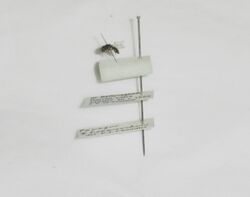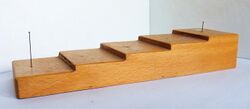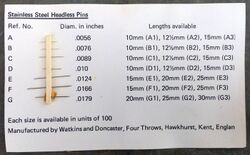Engineering:Insect pins


Insect pins are used by entomologists for mounting collected insects.[2] They can also be used in dressmaking for very fine silk or antique fabrics.[3]
As standard, they are 38 millimetres (1.5 in) long and come in sizes from 000 (the smallest diameter), through 00, 0, and 1, to 8 (the largest diameter).[2][4][5] The most generally useful size in entomology is size 2, which is 0.46 millimetres (0.018 in) in diameter, with sizes 1 and 3 being the next most useful.[2][4]
They were once commonly made from brass or silver, but these would corrode from contact with insect bodies and are no longer commonly used.[2] Instead they are nickel-plated brass, yielding "white" or "black" enameling, or even made from stainless steel.[4] Similarly, the smallest sizes from 000 to 1 used to be impractical for mounting until plastic and polyethylene became commonly used for pinning bases.[2]
There are also micro-pins, which are 10–15 millimetres (0.39–0.59 in) long.[4] minutens are headless micropins that are generally only made of stainless steel, used for double-mounting, where the insect is mounted on the minuten, which is pinned to a small block of soft material, which is in turn mounted on a standard, larger, insect pin.[6][7]
References
Cross-reference
- ↑ Ghafouri Moghaddam, Mohammad Hossein; Ghafouri Moghaddam, Mostafa; Rakhshani, Ehsan; Mokhtari, Azizollah (9 October 2017). "An Upgrade Pinning Block: A Mechanical Practical Aid for Fast Labelling of the Insect Specimens". Biodiversity Data Journal 5 (5): e20648. doi:10.3897/BDJ.5.e20648. PMID 29104440.
- ↑ 2.0 2.1 2.2 2.3 2.4 Gibb & Oseto 2010, p. 53.
- ↑ Denham & Field 2014, p. 39.
- ↑ 4.0 4.1 4.2 4.3 Dhooria 2009a, p. 114.
- ↑ Banks 1909, p. 53.
- ↑ Gibb & Oseto 2010, pp. 55–56.
- ↑ Dhooria 2009b, p. 146.
Sources
- "Insect pins". Springer Science + Business Media. 2009a. ISBN 9781402086441.
- "Minuten pins". Springer Science + Business Media. 2009b. ISBN 9781402086441.
- "Directions for Collecting and Preserving Insects". Bulletin (Smithsonian Institution, United States National Museum) (67). 1909.
- Arthropod Collection and Identification: Laboratory and Field Techniques. Academic Press. 2010. ISBN 9780080919256.
- Merchant & Mills Sewing Book. Collins & Brown. 2014. ISBN 9781910231012.
 |


